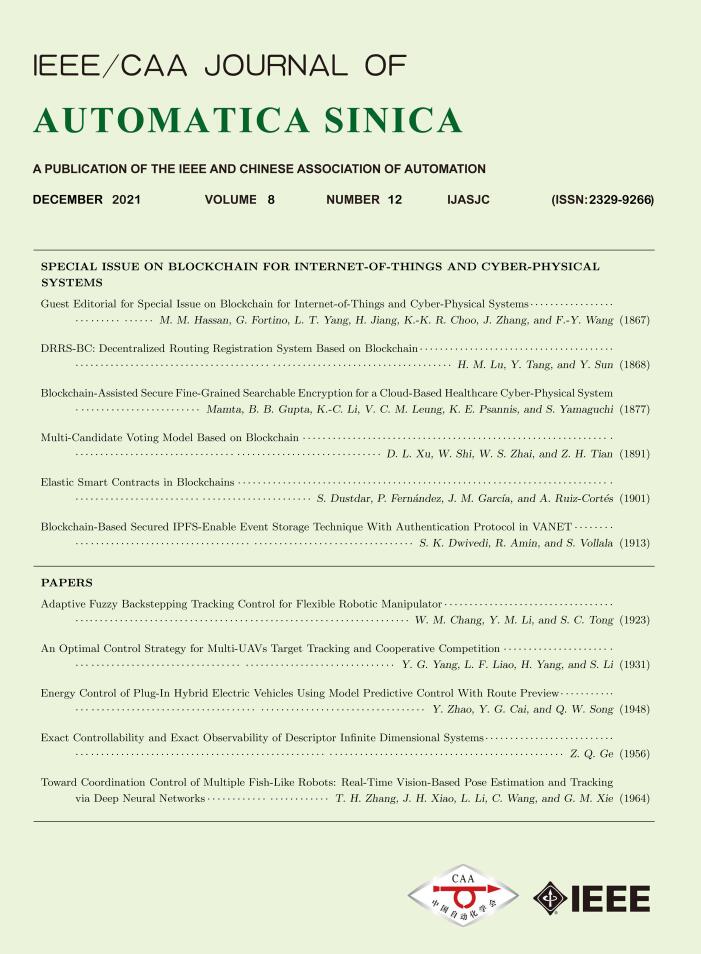 Volume 8
Issue 12
Volume 8
Issue 12
IEEE/CAA Journal of Automatica Sinica
| Citation: | H. M. Lu, Y. Tang, and Y. Sun, "DRRS-BC: Decentralized Routing Registration System Based on Blockchain," IEEE/CAA J. Autom. Sinica, vol. 8, no. 12, pp. 1868-1876, Dec. 2021. doi: 10.1109/JAS.2021.1004204 |

| [1] |
S. Murphy, BGP Security Vulnerabilities Analysis, RFC 4272, 2006.
|
| [2] |
O. Nordström and C. Dovrolis, “Beware of BGP attacks,” ACM SIGCOMM Comput. Commun. Rev., vol. 34, no. 2, pp. 1–8, Apr. 2004. doi: 10.1145/997150.997152
|
| [3] |
T. Wan and P. C. van Oorschot, “Analysis of BGP prefix origins during Google’s May 2005 outage,” in Proc. 20th IEEE Int. Parallel & Distributed Processing Symp., Rhodes, Greece, 2006.
|
| [4] |
R. Blog, “Con-Ed steals the net,” [Online]. Available: http://www.renesys.com/blog/2006/01/coned_steals_the_net.shtml. Accessed on: 2006.
|
| [5] |
R. Blog, “Pakistan hijacks YouTube,” [Online]. Available: http://www.renesys.Com/blog/2008/02/pakistan_hijiacks_youtube_1.shtml. Accessed on: 2008.
|
| [6] |
Sohu News, “Google accidentally hijacked BGP routes,” [Online]. Available: http://www.sohu.com/a/168006154_257305. Accessed on: Aug. 29, 2017.
|
| [7] |
S. Kent, C. Lynn, and K. Seo, “Secure border gateway protocol (S-BGP),” IEEE J. Sel. Areas Commun., vol. 18, no. 4, pp. 582–592, Apr. 2000. doi: 10.1109/49.839934
|
| [8] |
S. T. Kent, “Securing the border gateway protocol: A status update,” in Proc. 7th IFIP TC-6 TC-11 Int. Conf. Communications and Multimedia Security, Torino, Italy, 2003.
|
| [9] |
S. Kent, C. Lynn, J. Mikkelson, and K. Seo, “Secure border gateway protocol (S-BGP)—Real world performance and deployment issues,” in Proc. Network and Distributed System Security Symp., San Diego, USA, 2000.
|
| [10] |
R. White, “Securing BGP through secure origin BGP (soBGP),” Bus. Commun. Rev., vol. 33, no. 5, pp. 47–53, 2003.
|
| [11] |
G. Huston, M. Rossi, and G. Armitage, “Securing BGP—A literature survey,” IEEE Commun. Surv. Tut., vol. 13, no. 2, pp. 199–222, Jan. 2011. doi: 10.1109/SURV.2011.041010.00041
|
| [12] |
P. C. van Oorschot, T. Wan, and E. Kranakis, “On interdomain routing security and pretty secure BGP (psBNGP),” ACM Trans. Inf. Syst. Secur., vol. 10, no. 3, p. 11, Jul. 2007.
|
| [13] |
X. J. Hu, “Research on inter-domain routing system security,” Ph.D. dissertation, National Univ. Defense Technology, Changsha, China, 2009.
|
| [14] |
Y. Gilad, A. Cohen, A. Herzberg, M. Schapira, and H. Shulman, “Are we there yet? On RPKI’s deployment and security,” in Proc. NDSS Symp., San Diego, USA, 2017.
|
| [15] |
D. Cooper, E. Heilman, K. Brogle, L. Reyzin, and S. Goldberg, “On the risk of misbehaving RPKI authorities,” in Proc. 12th ACM Workshop on Hot Topics in Networks, College Park, USA, 2013, pp. 16.
|
| [16] |
E. Heilman, D. Cooper, L. Reyzin, and S. Goldberg, “From the consent of the routed: Improving the transparency of the RPKI,” ACM SIGCOMM Comput. Commun. Rev., vol. 44, no. 4, pp. 51–62, Oct. 2014.
|
| [17] |
H. Birge-Lee, Y. X. Sun, A. Edmundson, J. Rexford, and P. Mittal, “Bamboozling certificate authorities with BGP,” in Proc. 27th USENIX Security Symp., Baltimore, USA, 2018, pp. 833–849.
|
| [18] |
Q. Q. Xing, B. S. Wang, and X. F. Wang, “BGPcoin: Blockchain-based internet number resource authority and BGP security solution,” Symmetry, vol. 10, no. 9, p. 408, Sept. 2018.
|
| [19] |
A. Buzachis, A. Celesti, A. Galletta, M. Fazio, G. Fortino, and M. Villari, “A multi-agent autonomous intersection management (MA-AIM) system for smart cities leveraging edge-of-things and blockchain,” Inf. Sci., vol. 522, pp. 148–163, Jun. 2020. doi: 10.1016/j.ins.2020.02.059
|
| [20] |
G. Fortino, F. Messina, D. Rosaci, and G. M. L. Sarné, “Using blockchain in a reputation-based model for grouping agents in the internet of things,” IEEE Trans. Eng. Manage., vol. 67, no. 4, pp. 1231–1243, Nov. 2020. doi: 10.1109/TEM.2019.2918162
|
| [21] |
G. Fortino, F. Messina, D. Rosaci, and G. M. L. Sarne, “ResIoT: An IoT social framework resilient to malicious activities,” IEEE/CAA J. Autom. Sinica, vol. 7, no. 5, pp. 1263–1278, Sept. 2020. doi: 10.1109/JAS.2020.1003330
|
| [22] |
R. Casadei, G. Fortino, D. Pianini, W. Russo, C. Savaglio, and M. Viroli, “Modelling and simulation of opportunistic IoT services with aggregate computing,” Future Generat. Comput. Syst., vol. 91, pp. 252–262, Feb. 2019. doi: 10.1016/j.future.2018.09.005
|
| [23] |
G. R. Alam, M. M. Hassan, Z. Uddin, A. Almogren, and G. Fortino, “Autonomic computation offloading in mobile edge for IoT applications,” Future Generat. Comput. Syst., vol. 90, pp. 149–157, Jan. 2019. doi: 10.1016/j.future.2018.07.050
|
| [24] |
G. Fortino, D. Parisi, V. Pirrone, and G. Di Fatta, “BodyCloud: A SaaS approach for community body sensor networks,” Future Generat. Comput. Syst., vol. 35, pp. 62–79, Jun. 2014. doi: 10.1016/j.future.2013.12.015
|